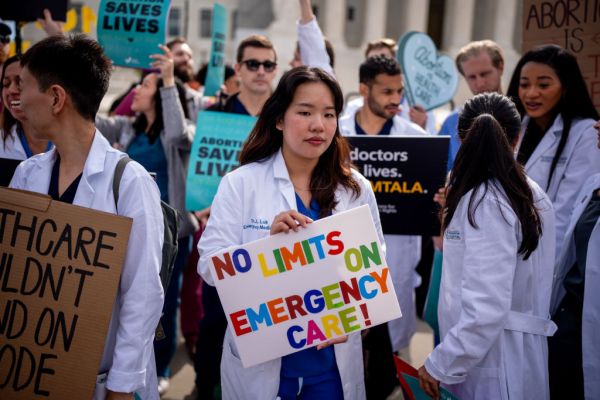Last summer, the Supreme Court punted a case involving abortion in cases of medical emergencies back to the lower courts—in part, because some Supreme Court justices were unsure whether there was really a conflict between federal and state law.
In 2022, the Biden administration sued the state of Idaho, arguing that the state’s abortion ban was too restrictive and that it needed to be enjoined to the extent that it conflicted with a federal law—the Emergency Medical Treatment and Active Labor Act (EMTALA)—that requires hospitals that accept federal funding to provide care to pregnant women and their unborn children experiencing medical emergencies. The state of Idaho fought back in federal court, under the belief that the Biden administration was arguing for a broad loophole that would allow abortion for reasons of mental health.
But by the time the case, Moyle v. United States, was argued before the Supreme Court, the Biden administration’s solicitor general told the justices that EMTALA would never require abortion for reasons of mental health. The Biden administration identified several life-threatening physical conditions that may require the termination of a pregnancy, but the state of Idaho told the Supreme Court that every one of those conditions was immediately treatable under the state abortion law’s exception to protect the life of the mother.
Justice Amy Coney Barrett, joined by Chief Justice John Roberts and Justice Brett Kavanaugh, wrote in an opinion that it was unclear there was a conflict between what the Biden administration was saying federal law requires and what Idaho’s abortion law allows. The case was sent back down to lower courts for review, but it now appears unlikely there will be a clear legal resolution to the case.
Last week, the Trump administration rescinded the Biden administration’s guidance letter on EMTALA. The Centers for Medicare and Medicaid Services (CMS), the agency charged with enforcing EMTALA, announced that while the Biden administration’s guidance does “not reflect the policy of this Administration,” CMS “will continue to enforce EMTALA, which protects all individuals who present to a hospital emergency department seeking examination or treatment, including for identified emergency medical conditions that place the health of a pregnant woman or her unborn child in serious jeopardy.” Dr. Mehmet Oz, the CMS administrator, wrote on X: “The Biden Administration created confusion, but EMTALA is clear and the law has not changed: women will receive care for miscarriage, ectopic pregnancy, and medical emergencies in all fifty states—this has not and will never change in the Trump Administration.”
The CMS announcement said the agency “will work to rectify any perceived legal confusion and instability created by the former administration’s actions.” But the agency, which did not reply to an interview request from The Dispatch, hasn’t yet taken any public action aside from that one-paragraph statement and a tweet from Dr. Oz.
There has never been a good legal reason for hospitals to delay treatment for pregnant women with life-threatening conditions, but it is nevertheless true that policymakers at both the federal and state level should do more to ensure hospitals provide proper care to them.
Contrary to many misleading claims, no American abortion law in any state requires waiting to act until a threat to a mother’s life is imminent. In the three years since the Dobbs decision overturned Roe v. Wade and returned the abortion question to the states, no doctor has been prosecuted for performing an abortion to treat a serious medical condition. In fact, in the past three years, there’s been only one case of a medical professional being arrested under a post-Dobbs abortion law—a midwife in Texas and her employee were arrested this year for allegedly performing elective abortions.
While there’s no good legal reason for hospitals to mistreat pregnant women, there’s no doubt that some hospitals have done exactly that following the Dobbs decision.
Consider Texas, the largest state with a law that generally prohibits abortion. ProPublica reported last month that since the Dobbs decision, different hospitals in Texas have treated life-threatening conditions differently. In cases of previable premature rupture of membranes (PPROM)—when a pregnant woman’s water breaks before the unborn child is able to survive outside the womb—the mother is at risk of quickly developing sepsis. The standard of care, according to the American College of Obstetrics and Gynecology, is to offer a pregnant woman both immediate delivery and expectant management (to closely monitor the situation because some unborn children can survive to viability without a dangerous infection developing). But ProPublica reported that although hospitals in the Dallas area have followed that standard since around the time of the Dobbs decision, hospitals in the Houston area have advised doctors to wait until a pregnant woman’s condition was dire.
“The Texas Supreme Court has said that doctors can legally provide abortions in PPROM cases, even when an emergency is not imminent,” ProPublica reported. “Yet legal departments at many major Houston hospitals still advise physicians not to perform abortions in these cases, doctors there told ProPublica, until they can document serious infection.” The result has been a sharp uptick in sepsis cases in Houston: While the rate of sepsis in second trimester pregnancy losses spiked to 6.7 percent in Houston in 2023, the rate was 4 percent that year in Dallas (close to where it was in 2019 when abortion was legal).
If hospitals in the same state operating under the same law have different policies with different outcomes for pregnant women, it’s hard to blame Texas’ law for advice that lawyers and bureaucrats continue to give to doctors at Houston hospitals—especially given the Texas Supreme Court ruling that explicitly stated that doctors are not required to wait for serious infection to develop.
Some in Texas are hopeful new legislation will finally resolve the matter. Now awaiting the signature of Gov. Greg Abbott, the Life of the Mother Act passed the state Senate unanimously and on a 134-4 vote in the House last month. The bill’s sponsor, Sen. Bryan Hughes, told the Austin American-Statesman the law is intended to “remove any excuse” for hospitals withholding proper care for women with dangerous conditions. Among other provisions, the bill would make it explicit that a threat to a mother needn’t be imminent and provides greater clarity that the exception applies to threats to major bodily functions, not merely threats to life.
But the most important provision of the bill may be its requirement for continuing medical education for doctors and continuing legal education for hospital lawyers about Texas’s abortion law. The state communicating directly with doctors in a way that “explains what is permitted of them, what is expected of them” could finally get hospitals to stop mistreating pregnant women, according to Dr. Ingrid Skop, a Texas-based obstetrician. After the Dobbs decision, Skop co-authored a paper for the Charlotte Lozier Institute (the research arm of Susan B. Anthony Pro-Life America) explaining that every state abortion law in the United States allowed doctors to continue to follow the same standards of care for treating serious medical conditions in pregnant women, and she urged medical associations and policymakers to convey that information to hospitals.
Last year, South Dakota was the first state to pass a medical education bill that provides guidance directly to doctors about standards of care and some of the most common life-threatening conditions, including PPROM. In addition to Texas, other medical education bills have worked their way through legislatures this year in North Dakota, Arkansas, and Kentucky. Executive branch health officials in other states, including Florida and Nebraska, have communicated directly with doctors via letters or email to explain the exceptions in abortion laws.
But not every state has done so. In Idaho, for example, the state Supreme Court has clarified that a life-threatening condition does not need to be imminent for a pregnant woman to receive treatment, and state officials argued before the U.S. Supreme Court that every life-threatening condition identified by the Biden administration is immediately treatable under state law. But the state has not issued guidance communicating that information directly to doctors, and the state’s largest hospital has insisted that without an ongoing court order, Idaho’s abortion law means it must airlift women out of the state when they are diagnosed with conditions such as previable rupture of membranes.
Officials in Idaho did not respond to interview requests, but John Bursch, senior counsel with the legal advocacy group Alliance Defending Freedom and co-counsel to the state of Idaho in the EMTALA case, told The Dispatch he expects state officials will issue guidance. “It's difficult to clarify how federal and state law work together, when the federal government's interpretation of federal law is changing midstream,” he said. “I strongly suspect that they're working on [guidance] now that they have a definitive interpretation of EMTALA from the new administration.”
There is only so much that policymakers can do to get hospitals to take yes for an answer, of course. As Vox reported last fall, some abortion-rights advocates “fear half-measures could undermine their long-term goals.” Some in the abortion-rights movement are wedded to the notion that exceptions to abortion prohibitions cannot work.
But there is still much more that policymakers can do to fix a problem that never should have existed in the first place. The Trump administration could provide more clarity than a tweet from Dr. Oz and a one-paragraph statement about how it will enforce EMTALA. And it could work with all pro-life states to provide clarity directly to doctors and hospitals about exceptions.
If both sides of the abortion debate agree on how to approach this critical but very small number of cases involving abortion, they ought to take a moment in a non-election year to find a way to make that agreement work in reality.







Please note that we at The Dispatch hold ourselves, our work, and our commenters to a higher standard than other places on the internet. We welcome comments that foster genuine debate or discussion—including comments critical of us or our work—but responses that include ad hominem attacks on fellow Dispatch members or are intended to stoke fear and anger may be moderated.
With your membership, you only have the ability to comment on The Morning Dispatch articles. Consider upgrading to join the conversation everywhere.